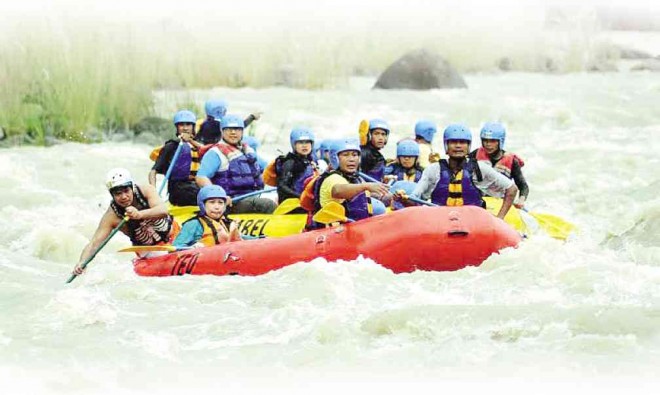Nature, rapids help shoot down Kalinga bad image

The raging waters of the Chico River have given Kalinga one of its most important attractions as tourists are drawn to whitewater rafting in this Cordillera province. EV ESPIRITU/INQUIRER NORTHERN LUZON
TABUK CITY—There was once a time when the mere mention of Kalinga would evoke images of tribal wars, insurgency and crime. Outsiders—even Kalinga natives living elsewhere—avoided the province like the plague.
“Nasaan ’yon? (Where’s that?)” comes the inevitable question whenever Kalinga, or its capital, Tabuk City, is cited as one’s place of origin.
The negative image still persists today, but people are now more open to visiting the province and less ignorant about the location of Kalinga (pop: 201,613 as of May 2010) in the Philippine map.
Natividad Sugguiyao, founder of Chico River Quest Inc. (CRQI), the lone whitewater rafting group operating in the Chico River, likes to think that Kalinga’s natural attractions and water adventure sport have helped reverse the negative perception about this Cordillera province.
“At least, we have helped change the image of Kalinga to more positive terms,” she says.
Before, the first things that came to mind when Kalinga was mentioned in conversations were headhunting, marijuana, tribal wars, New People’s Army ambushes and other negative impressions, Sugguiyao says. Now, she adds, the province carries a positive tagline, “Whitewater Rafting Capital of the North.”
“That’s a profound contribution which gives me personal fulfillment. We now hear outsiders say, ‘Tara na sa Kalinga, mag-whitewater rafting,’” she says.
Ecotourism
Sugguiyao says Chico River’s inclusion in the ecotourism map, through whitewater rafting and kayaking, in 2002 began much earlier in 1995, when Gary Fondren of Ashford City, Oregon, read about the Chico Dam conflict in the 1970s and searched the river’s images through the Internet.
Fondren was instantly enamored with the Chico River because it was tagged as one of the longest in the country and is found in a mountainous region. Together with Oregon natives and adventurers, Ned Sickels and Dr. Bob Anderson, he visited the country in November 1996 to explore the river.
Sugguiyao and the group made the maiden rafting trip with then Mt. Province Gov. Maximo Dalog, Kalinga Board Member Andres Ngao-i, and Tinglayan (Kalinga) Mayor Fernando Abay. The trip started in Sabangan, Mt. Province, and ended in Tabuk, Kalinga, four days later.
The Americans declared the river a world-class rafting destination, citing its “location, culture and the people.”
Sickels, Sugguiyao says, believed that locals should benefit from the activity that would spur the development of a community-based ecotourism outfit.
“He trained us to manage the operation and also to work as guides. After our training, we went through the process of incubation. We had to do marketing and promotion through familiarization tours of the media and travel agencies,” she says.
CRQI has two rafting legs—the Matagoan Run, which begins in Tinglayan town down to the confluence of the Chico and Pasil rivers in the village of Dupag in Tabuk, and the Ullalim Run which ends in the community of Dalimuno in the village of Bantay in Tabuk. It combines the two legs into what it calls the “Chico River Challenge.”
The International Scale of River Difficulty starts from Grade 1, which is characterized by “very small rough areas,” to Grade 6, which is described as extremely dangerous where rafters court serious injuries or even death.
Challenging
Sugguiyao says the Matagoan Run, which takes about five hours, is more challenging because of drops and holes, categorized as Grades 3 to 5, that demand higher level of rafting skills. This section features narrow canyons and scenic wilderness.
The Ullalim Run, categorized as Grades 3 to 4, is for beginners and without the hard continuous rapids of the Matagoan.
Since 2011, the CRQI has been offering only the Ullalim Run, which costs P2,500 per head, because the Tinglayan guides have been leaving for jobs elsewhere, and there is no access to the river from Tinglayan to Dupag village, making rescue in case of accidents very difficult.
CRQI, however, offers the Matagoan Run and the Chico River Challenge on special arrangement at P6,000 and P8,000 per head, respectively.
Sugguiyao admits that even after more than a decade, the group’s operation has yet to reach commercial level unlike in Cagayan de Oro City, where guests flow continuously. Besides, Cagayan de Oro is more accessible and has all the tourism-related services nearby, she says.
CRQI has an average of only two trips a month during the rafting season from June to December. Visitors need at least two days for rafting in the Chico River.
Sugguiyao says whitewater rafting has equipped guides with knowledge on caring and nurturing the environment and with skills to become the province’s foremost tourism promoters. It has also contributed to the marketing of local products, such as heirloom rice and coffee, and spawned tourism-related businesses in transportation, food, accommodation and native crafts.














